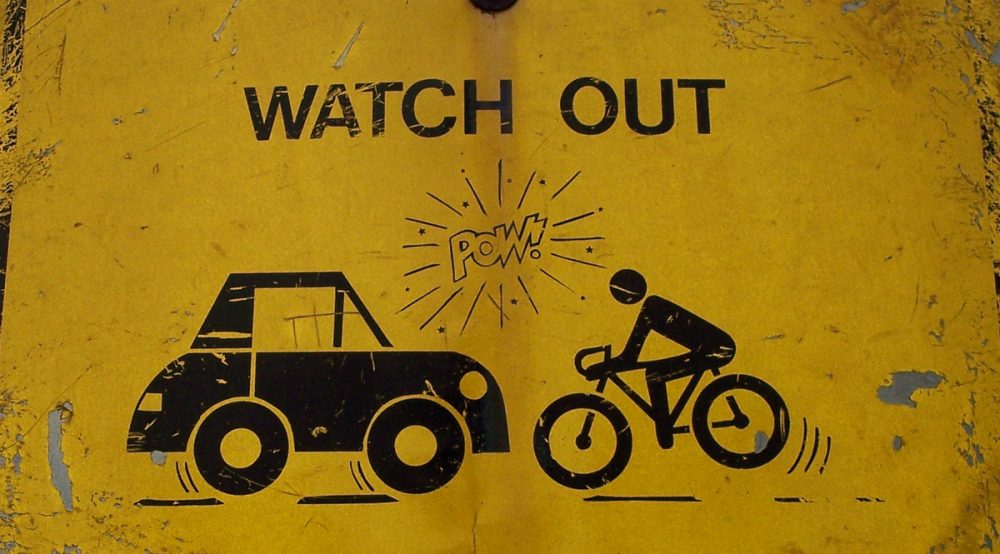Advertisement
Keep Rollin': A Cyclist's Case For The Idaho Stop

There’s a corner outside Kendall Square in Cambridge, Mass., that serves as a kind of Bermuda Triangle for cyclists. Well, at least for me. I’ve twice been struck by drivers attempting to park there, and this week I nearly had a third chance, thanks to a driver in a blue Audi TT.
It was a standard affair. He cut me off in the bike lane while he was trying to pull up to a metered spot. I gave him a mean look as I slowly arced around the driver’s side. He paused, still occupying the bike lane, exited the car and, an unmistakable edge in his voice, asked what I would have him do. “Wait for the bike lane to empty before you enter it,” I answered from the sidewalk, with the edge to match. “Of course,” he responded, “because it’s all about you.”
We are a fraternity of fighters, and the pavement is our ring. Whether on two wheels or four -- and even on our feet, we are all Boston drivers: ruthless, uncompromising and no less than half-crazy.
Ah, yes, the entitlement insult. Cyclists are used to it by now. Still, it was an incongruous retort from a man driving a $40,000 imported sports car, into which he immediately retreated rather than hear if I had anything further to say. It’s fine; I didn’t.
As a daily bike commuter, I log about seventy-five miles a week in and around Boston on a well-nicked piece of steel. I also learned to drive here and have done so for about fifteen years, so I’ve seen this contest of passions from both sides. And my conclusion from this experience is that the first thing we can do to improve safety on our roads is to admit that we are all at fault. We are a fraternity of fighters, and the pavement is our ring. Whether on two wheels or four — and even on our feet — we are all Boston drivers: ruthless, uncompromising and no less than half-crazy.
Recognizing this, our best hope is to minimize interaction between cyclists and drivers and ensure, as much as possible, predictable behavior by all road users. One small part of the solution is now under consideration in Brookline, Mass. On Wednesday, September 17, the town’s police department posed a simple question to the public, via Twitter: “Should we allow cyclists to use Idaho Stop’s?” [sic]
The answer is yes.
The Idaho stop, which has been law in the state after which it was named since 1982, is so intuitive that, if you’re a cyclist, you may already do it, even if it’s not legal where you ride. All it means is that, for cyclists, red lights are equivalent to stop signs, and stop signs equivalent to yields.
As Vox explained in a thorough discussion of the Idaho stop’s benefits, this is valuable for cyclists because it saves them energy by preventing momentum loss at intersections.
But the Idaho stop is not only easier; it may also be safer. Vox cites research to this effect, and, frankly, it just makes sense. I bike hard in order to get off the road. My theory is not complicated: spend as little time as possible where the cars are. The Idaho stop facilitates this by enabling cyclists to keep moving rather than mob with drivers at red lights.
Response to Brookline’s decidedly unscientific poll was largely positive, though naysayers made their voices heard, suggesting that instead of writing new rules, police should enforce existing laws and ticket cyclists. But this points to another benefit of the Idaho stop: Implementing it would bring the law into alignment with reality. Some cyclists already break red light laws, and others don’t, creating confusion. Get everyone on the same page, and roads will be more predictable.
My theory is not complicated: spend as little time as possible where the cars are. The Idaho stop facilitates this by enabling cyclists to keep moving rather than mob with drivers at red lights.
Some cyclists do illegal things, such as cutting off pedestrians in crosswalks. This fuels the just-ticket-them crowd, which senses a penchant for lawbreaking. But it is a parochial complaint, and not really fair, because pretty much everyone breaks traffic laws. Pedestrians jay-walk. Drivers fail to signal turns. They take the speed limit as a suggested minimum rather than maximum. And they speed up through yellow lights. It’s just that we’re so used to these infractions we don't notice them anymore.
This is not to say that cyclists are innocents and that everyone else is in the wrong. In fact, most of us on the road are covered in the same grime. There are a few saints, and I feel for them. The rest of us devise schemes, possibly illegal, to secure our own safe and efficient movement.
Let’s accept that rather than quarrel over our biases. Sometimes, we’re better off with rules, such as the Idaho stop, that acknowledge and accommodate our collective aggressiveness.
Related:
- Radio Boston: 10 Ways Boston Can Beat Portland As America’s Most Bike Friendly City
- On Point: Cyclist Culture: Pedaling Attitude
- Cognoscenti: Why I Ride My Bike — And Why You Should Too
